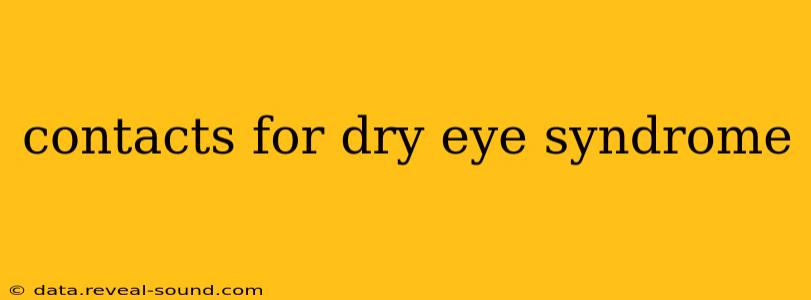Dry eye syndrome can significantly impact your comfort and vision, especially when wearing contact lenses. Finding the right contacts is crucial for managing symptoms and maintaining clear vision. This guide explores the best contact lens options for individuals with dry eye, addressing common concerns and providing practical advice.
What Causes Dry Eye and How Do Contacts Affect It?
Dry eye syndrome occurs when your eyes don't produce enough tears or produce poor-quality tears that evaporate too quickly. This leads to irritation, burning, stinging, and blurry vision. Contact lenses can exacerbate dry eye symptoms because they interfere with the natural tear film, reducing the amount of moisture reaching the cornea. The lens itself can also absorb some of the available moisture. Furthermore, certain lens materials and designs are more likely to contribute to dryness than others.
What Types of Contact Lenses are Best for Dry Eyes?
Several contact lens types are designed to minimize dryness and discomfort for those with dry eye syndrome. Let's explore the key options:
1. Daily Disposable Contact Lenses:
These lenses are discarded after each use, eliminating the buildup of protein deposits and debris that can irritate dry eyes. The fresh lens each day provides a consistently clean and moist surface. Many daily disposables are made with materials that are highly breathable and promote oxygen flow to the cornea, reducing dryness.
2. Silicone Hydrogel Contact Lenses:
Silicone hydrogel contact lenses are highly permeable to oxygen. This increased oxygen transmission is key because it helps to maintain the health of the cornea and prevent dryness and discomfort. These lenses allow more oxygen to reach your eyes, which helps to keep them moist and comfortable, even during extended wear periods (with your eye doctor's recommendation).
3. Larger Diameter Lenses:
While not always a solution, some individuals find that larger diameter lenses distribute tears more evenly across the eye's surface, potentially reducing dryness. However, this should be determined in consultation with an eye care professional as larger lenses may not be suitable for all.
4. Multifocal Lenses for Presbyopia and Dry Eye:
For those needing correction for presbyopia (age-related vision changes) and dealing with dry eye, there are multifocal silicone hydrogel daily disposable lenses designed with both conditions in mind. These combine the benefits of the above-mentioned lens types with presbyopia correction.
H2: What Contact Lens Solutions Should I Use?
The solution you use with your contact lenses also significantly impacts dryness. Look for solutions that are specifically designed to hydrate and lubricate the eyes. Some solutions contain ingredients like hyaluronic acid, which help retain moisture and soothe irritated eyes. Always follow your eye doctor's recommendations for lens care and solution usage.
H2: Are There Contact Lens Brands Specifically Designed for Dry Eyes?
Many reputable contact lens brands offer lenses designed with dry eye sufferers in mind. Your eye care professional can recommend brands and lens types that best suit your individual needs and eye condition. The specific brands vary, and it’s essential to discuss options during your eye exam.
H2: How Often Should I See My Eye Doctor?
Regular check-ups with your eye doctor are crucial for managing dry eye syndrome, especially if you wear contact lenses. They can monitor your eye health, assess your dryness levels, and adjust your contact lens prescription or solution as needed. Don't hesitate to contact them if you experience any significant changes in your comfort or vision.
H2: What If My Dry Eye Symptoms Persist Even With New Contacts?
If you continue to experience dry eye symptoms even after switching to more suitable lenses and solutions, it's essential to consult your eye doctor. Underlying medical conditions could contribute to your dry eye, requiring further investigation and treatment. They might recommend additional treatments, such as artificial tears, eye drops, or other therapies.
Conclusion:
Choosing the right contact lenses is crucial for managing dry eye syndrome. By working closely with your eye doctor and considering the factors discussed above, you can find a solution that provides comfort, clear vision, and promotes the health of your eyes. Remember, individual needs vary, and professional guidance is essential for optimal results.
